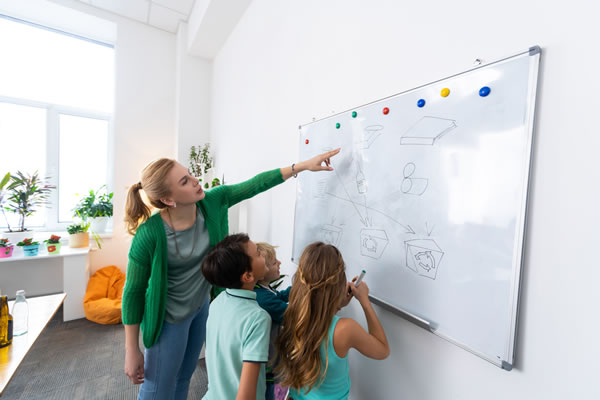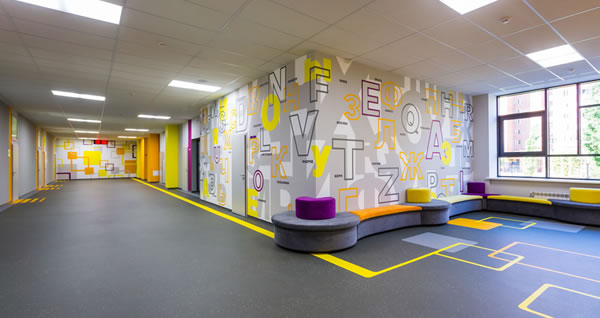Shining a Light on Success in the Classroom
What Role Does Lighting Design Play in Student Outcomes?
How students are taught continues to evolve at
the same pace as our understanding of how students learn.
As we have observed more clearly that children exhibit a
wide range of learning styles, we have more boldly recognized that
these differences are “a biologically and developmentally imposed
set of personal characteristics that make the same teaching method
effective for some and ineffective for others. Every person has a
learning style — it’s as individual as a signature.” In turn, teachers
have responded to this reality by offering content in various formats,
even embracing their students’ use of mobile devices. They
are some of the most ardent champions of research that identifies
and leverages each student’s personal preferences to create better
learning outcomes.

PHOTO © DMYTRO ZINKEVYCH
Within this range of “learning style variations”, one dimension
that we as architects can directly influence is “Environmental
Design,” which includes sound, light, temperature, and seating design. Knowing the importance of these
parameters, we should all be changing the
way we look at the physical arrangements
in which our teachers teach; no longer is
a one-size-fits-all approach deemed successful
for most students. Rather, flexible
learning spaces must be intentionally
designed to respond to the gamut of human
needs our children experience daily; only
then can we elevate the level of education
they receive, and ultimately the level of
success they achieve.
Accommodating a Range of
Early Developmental Milestones
The range of ages that must all be accommodated
inside of a single elementary school
building spans from highly-active, emotionally-developing kindergarteners to fourth
and fifth graders whose bodies are beginning
to change rapidly, often leaving them
uncertain of themselves and overly anxious
about peer scrutiny. Additionally, a variety
of learner-centered classroom elements are
needed to respond to the “29 percent of all
students who are visual learners, 34 percent
who learn through auditory means, and
37 percent who learn through kinesthetic/tactile modes.” Relying on the significant
body of research on learning styles as a point
of reference for design equips teachers to
respond directly to each child’s needs.
Daylighting and
Elementary School Students

PHOTO © ANEK.SOOWANNAPHOOM
Physical, cognitive, language, and social
and emotional developmental milestones
give us clues as to how specific teaching
and learning environments can be
designed to best accommodate children at
each academic level. In 1999, the Heschong
Mahone Group conducted a groundbreaking
study on daylighting in elementary
schools. They found that the classrooms
with the most daylight are “associated with
a 20 percent to 26 percent faster learning
rate, as evidenced by increased student
test scores over one school year, compared
to classrooms with the least amount of
daylighting.” Because students in the most
daylit classrooms advance more quickly,
they can gain enough further understanding
of material over the course of a school
year to save up to one month of instruction
time in reading and math curriculum that
could be used for other areas of learning.
Maturity and Learning among Middle School Students
This We Believe: Successful Schools
for Young Adolescents, A Position Paper of
the National Middle School Association,
sounds the call for inviting, supportive,
and safe environments where students and
teachers engage in active learning. As we
know, middle school students are often
more physically mature than emotionally
mature due to a difference between body
and brain growth and development. The
significant differences in meeting developmental
milestones, as well as maturity
and confidence levels, result in middle
school students continuing to be especially
susceptible to peer pressure and bullying.
Policies and practices that directly promote
kindness, well-being, and healthfulness
are essential to proactively supporting
adolescents.
Motivation and Learning
among High School Students
By the time students reach the ninth or
tenth grade most have moved toward being
self-motivated and begin to prefer working
alone or in small groups much of the time.
Organizing learning spaces to accommodate
these preferences requires a different
spatial model. Students who feel connected
to their teachers and peers and who have
personally identify with a small learning
community (SLC) “attain higher test scores
and have a significantly greater graduation
rate. Research demonstrates that ‘small’ is
defined as 150 students or less. A study by
Albuquerque Public Schools demonstrates
conclusively that the positive effects of
120 student academies are completely lost
when the academies grow to 180.”
Lighting for
Individualized Learning
Within each grade level, however, we
must bear in mind that each student is
very different from the next. “Knowing
students’ learning styles, we can organize
classrooms to respond to their individual
needs for quiet or sound, bright or soft
illumination, warm or cool room temperatures,
seating arrangements, mobility, or
grouping preferences.”
We must also provide a range of
visual focal points. Unconsciously, people
frequently look up from a task and focus
on something else in their field of vision.
This gives them a chance to rest their eyes “by changing the focal length – a form of
stretching. Interior and exterior vistas
of 50 feet or more allow us to change our
focal length, important to eye health and
comfort. Instinctively, we tend to move
towards light and color.” Thus, elements
such as a view to the woods or the placement
of a brightly colored wall are essential
to our health and well-being. “Price (1980)
reported that the older students become,
the less they appear to be able to adapt
to a conventional setting.” Therefore, a
variety of design elements and layouts
may be far more essential to high school
students’ ability to concentrate and absorb
new information than to elementary school
children, who may be better able to adjust
to a less sophisticated school environment.
Lighting the Way to a Better
Educational Environment
What is clear is that no two students
approach their schoolwork in the same
manner. They each respond to their teachers
and learning environments in a unique
and specific way, dictated by their age, confidence
and personalities, learning styles,
and personal preferences. In turn, teachers
must deploy a variety of techniques and
strategies, which when used appropriately
at each grade level offer each student their
best chance to excel.
Among the many environmental factors
that support the educational curriculum
and set the stage for learning success at
any grade level, lighting plays perhaps the
most important role of all. The compelling
statistics on the impact of properly planned
lighting quality, availability, and flexibility
have been researched and documented for
over forty years, conclusively pointing to the
relevance and permanent benefits of properly
designing this critical element. Given that
these factors are both easy and practical to
plan and implement with today’s technological
capabilities, technical expertise, and
deeper understanding, we believe that proper
lighting design should now be considered
a standard practice for student success in
any 21st century learning environment.

PHOTO © ANDREI KHOLMOV
Parameters for
Successful Lighting Design
“Well-integrated daylighting design
has a greater positive impact on a school
than any other sustainable design strategy.
Daylighting done well can help improve
student performance, create a healthier
indoor environment, and increase attendance.”
Classrooms with significant levels
of daylight record math scores improved by
20 percent and verbal scores by 22 percent.
These results can be maximized by following
several basic parameters:
- Task Lighting: Evenly distributed 55
footcandle illumination across the entire
room is no longer the desired solution.
Lighting should be designed specific to
the tasks that will be performed in each
learning space.
- Orientation: North and south sunlight
provide a full spectrum of light
wavelengths and colors, best optimized
through the preferred east-west axis
building orientation.
- Daylit Hours: Providing superior
daylighting for two-thirds of daylit hours
throughout the year can be strategically
achieved by accommodating the winter
sun’s greater penetration into the room
versus the summer sun. Light shelves
and deciduous trees assist in bouncing
light deeper into the space during the
winter and help filter the more intense
summer sun.
- Control: A glow redirected from
dimmable LED uplights/downlights
and pendants on multiple circuits will
modulate the ambient light in the room,
while directional downlighting washes
the teaching wall. Additional downlighting
can be used to highlight student work
and pinpoint specific task areas.
When it isn’t possible to bring in optimal
levels of daylight, the broad spectrum
of light and color that most closely matches
daylight is appropriate. A color rendition
index (CRI) as close as possible to daylight,
which has a CRI of 100, will have the
most positive effects on attention paid to
educational programs, absorptive learning,
and overall health. Electrical lighting in
the room can be reduced by as much as
25 percent by also taking into account the
designed light reflective value (LRV) of the
ceiling and walls.
This article originally appeared in the School Planning & Management September 2019 issue of Spaces4Learning.